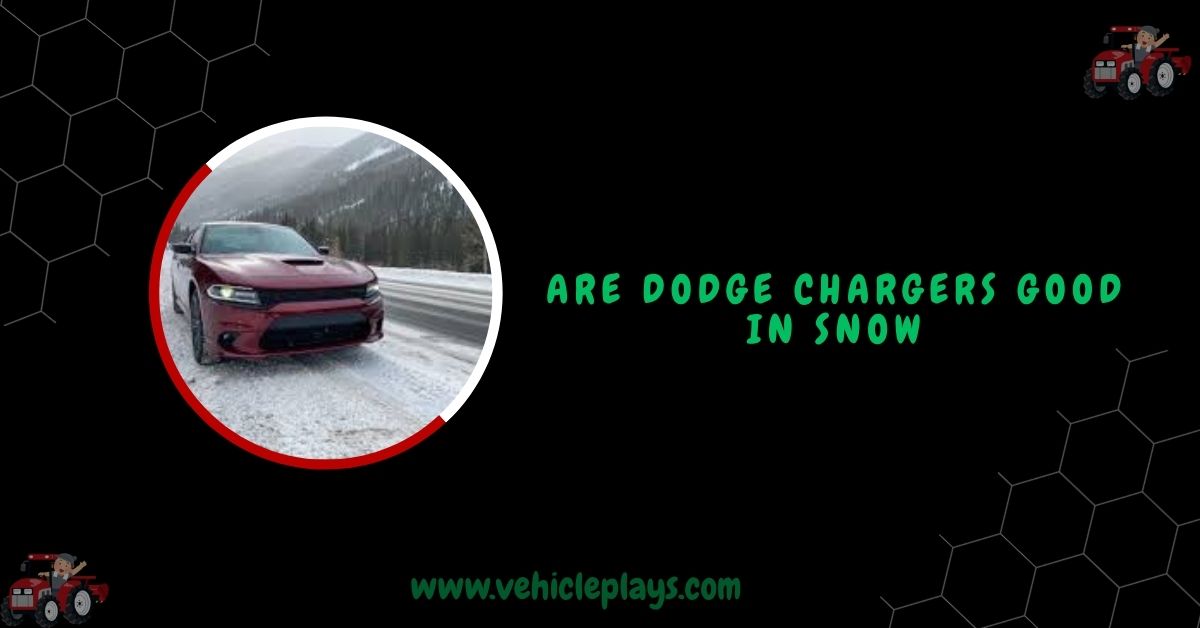When considering a Dodge Charger for winter driving, the question of its performance in snow is critical, especially for those living in regions with harsh winters.
Dodge Chargers with AWD and winter tires handle snow well, earning iSeeCars’ top pick. RWD models need careful driving and good tires, but low clearance struggles in heavy snow.
This article examines the snow handling capabilities of Dodge Chargers, comparing rear-wheel drive (RWD) and all-wheel drive (AWD) models, and offers insights into optimizing their winter performance.
Rear-Wheel Drive Chargers in Snow
Most Dodge Chargers come equipped with rear-wheel drive, a configuration that prioritizes performance but can pose challenges in snowy conditions.
RWD vehicles tend to have less traction when accelerating on slick surfaces because the rear wheels, responsible for propulsion, can lose grip easily.
However, advancements in technology and proper tire selection can significantly improve their winter performance.
Forum discussions and user experiences suggest that RWD Chargers, when fitted with quality winter tires, can handle light to moderate snow (3-6 inches) effectively.

For instance, a user on Charger Forums noted that their 2011 RWD Charger with snow tires performed well in Michigan winters, managing unplowed roads without getting stuck, provided the driver exercised caution.
Another user highlighted the effectiveness of the Charger’s traction control system, which helps manage wheel spin in slippery conditions, making it surprisingly capable even with all-season tires.
However, in heavy snow (6+ inches) or icy conditions, RWD Chargers may struggle, particularly on hills or from a dead stop, as noted in a BobIsTheOilGuy thread where users recommended avoiding steep inclines without AWD.
The key to enhancing RWD Charger performance in snow lies in tire choice. Winter tires, such as Nokian Hakkapeliittas or Bridgestone Blizzaks, provide better grip due to their softer rubber compounds and specialized tread patterns designed for low temperatures and snow.
Users also suggest adding weight to the trunk, such as sandbags, to improve rear traction, though this should be done cautiously to avoid affecting handling or causing corrosion from storing salt.
Additionally, disabling traction control in specific low-speed situations can allow drivers to better manage wheel spin, though this requires skill and experience.
All-Wheel Drive Chargers: A Winter Game-Changer
For those prioritizing winter capability, the Dodge Charger offers AWD options on select trims, such as the SXT and GT, paired with a 3.6L V6 engine.
The AWD system significantly enhances snow performance by distributing power to all four wheels, improving traction on slippery surfaces.
According to iSeeCars, the Dodge Charger AWD scored an impressive 8.8/10 for snow driving, earning it the top spot among large cars for winter conditions due to its grippy AWD system and safety features.
The Charger’s AWD system is rear-biased, operating in RWD mode under normal conditions to maintain fuel efficiency and the muscle car feel.
It seamlessly engages the front wheels when sensors detect wheel slip, rain, or low temperatures, providing confidence in adverse conditions.
A MotorTrend test in Quebec demonstrated the Charger AWD’s prowess on a snow-covered track, noting its ability to handle slaloms and corners with minimal oversteer when equipped with winter tires.
Owners in snowy regions like Alaska and Chicago have praised the AWD Charger’s stability, with one Reddit user describing it as a “snow plow” that handles plowed roads and light snow effortlessly.
However, AWD is not a standard feature and is only available on specific trims. For instance, high-performance models like the Scat Pack or SRT Hellcat are RWD-only, limiting their winter suitability unless paired with top-tier snow tires.
Even with AWD, winter tires are highly recommended, as all-season tires can harden in cold temperatures, reducing grip.
Quebec’s mandatory winter tire law underscores this, as AWD Chargers with all-season tires struggled in deep snow compared to those with proper winter rubber.
Key Features for Winter Driving
Dodge Chargers come equipped with several driver assists that enhance winter safety. Electronic Stability Control (ESC), All-Speed Traction Control, Anti-Lock Brakes (ABS), and Rain Brake Support work together to maintain control and braking power on slick roads.
Rain Brake Support, for example, activates when wipers are on, applying light brake pressure to keep pads dry, improving stopping power in wet or snowy conditions.
These features, combined with AWD, make the Charger a reliable option for winter driving, though it lacks a dedicated “Snow Mode” found in some competitors.
Ground clearance is a limitation, however. At just 4.9 inches, the Charger sits lower than SUVs or trucks, making it less suitable for deep snow or off-road conditions.
Owners are advised to avoid unplowed roads or areas where snow accumulation exceeds the car’s clearance.
Practical Tips for Winter Driving
To maximize a Dodge Charger’s snow performance, consider the following:
- Invest in Winter Tires: Opt for dedicated winter tires with the snowflake symbol, such as Michelin Pilot Alpin or Bridgestone Blizzak, for superior grip in cold and snowy conditions.
- Choose AWD if Possible: If you live in a snowy region, prioritize AWD trims (SXT or GT) for better traction and control.
- Add Weight Cautiously: Place sandbags in the trunk for RWD models to improve traction, but avoid storing salt to prevent corrosion.
- Drive Smart: Use gentle acceleration and braking, and practice in open areas to understand the car’s handling in snow. Disabling traction control in specific scenarios can help maintain momentum.
- Check Local Regulations: Ensure snow tires or chains comply with local laws, as some regions restrict studded tires or chains.
Are Dodge Chargers Good in Snow 2025?
In 2025, Dodge Chargers with AWD and winter tires handle snow well. RWD models need careful driving and good tires. Traction control helps, but low clearance struggles in deep snow.
Are Dodge Chargers Good in Snow 2022?
In 2022, Dodge Chargers handle snow decently with winter tires. AWD models, like the SXT, perform better than RWD. Traction control helps, but low ground clearance can struggle in deep snow.
Are Dodge Chargers Good in Snow 2021?
For 2021, Dodge Chargers with AWD and winter tires manage snow well. RWD models need careful driving and good tires. Traction systems help, but heavy snow or ice can challenge the car’s low clearance.
Dodge Charger RT in Snow
The Dodge Charger RT, being RWD, isn’t great in snow without winter tires. With good tires and traction control, it’s manageable in light snow, but struggles in deep snow due to low ground clearance.
Dodge Charger AWD V6
The Dodge Charger AWD V6, like the SXT or GT, is solid in snow with winter tires. Its AWD system boosts traction, making it reliable for winter roads, though deep snow can be tough.
Are Dodge Chargers Reliable?
Dodge Chargers are fairly reliable for a muscle car. Regular maintenance keeps them running well. Some owners report electrical or transmission issues, but overall, they’re durable with proper care, especially newer models.
FAQs
Do Chargers Work in Snow?
Dodge Chargers with AWD and winter tires work well in snow. RWD models need careful driving and good tires.
What Are the Disadvantages of the Dodge Charger?
Dodge Chargers have low ground clearance, high fuel costs, and some reliability issues. RWD struggles in snow, and interiors feel dated.
Is Dodge Good in Snow?
Dodge vehicles, like Chargers with AWD and winter tires, handle snow well. RWD models need caution and good tires.
Can You Put Snow Chains on a Dodge Charger?
Yes, you can use snow chains on a Dodge Charger, but check local laws and ensure they fit your tire size.
Can You Drive a Dodge Charger in Snow?
You can drive a Dodge Charger in snow with AWD and winter tires. RWD needs careful driving and good tires.
Conclusion
Dodge Chargers can be good in snow, but their performance depends on the drivetrain and preparation. RWD models, while capable with winter tires and cautious driving, are less ideal for heavy snow or icy hills. AWD Chargers, particularly the SXT and GT trims, excel in winter conditions, offering stability and traction comparable to SUVs when equipped with proper tires. Features like ESC and Rain Brake Support further enhance safety. However, low ground clearance and the need for winter tires are important considerations. For drivers in snowy climates, an AWD Charger with winter tires is a compelling choice, blending muscle car aesthetics with practical winter performance. Always prioritize driver skill and road conditions to ensure safe travels.
Also Read:

